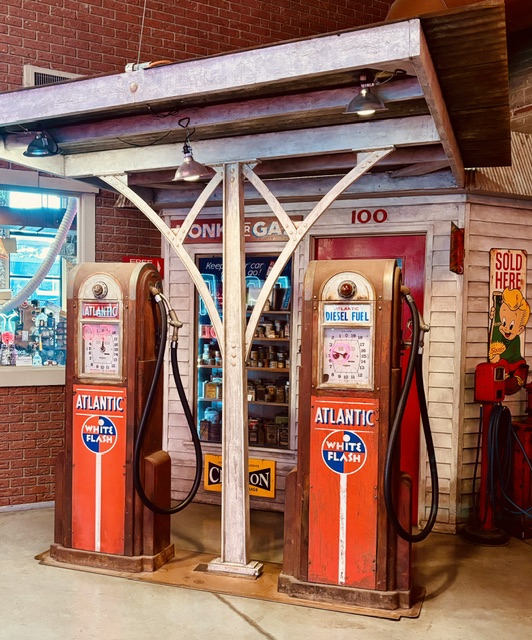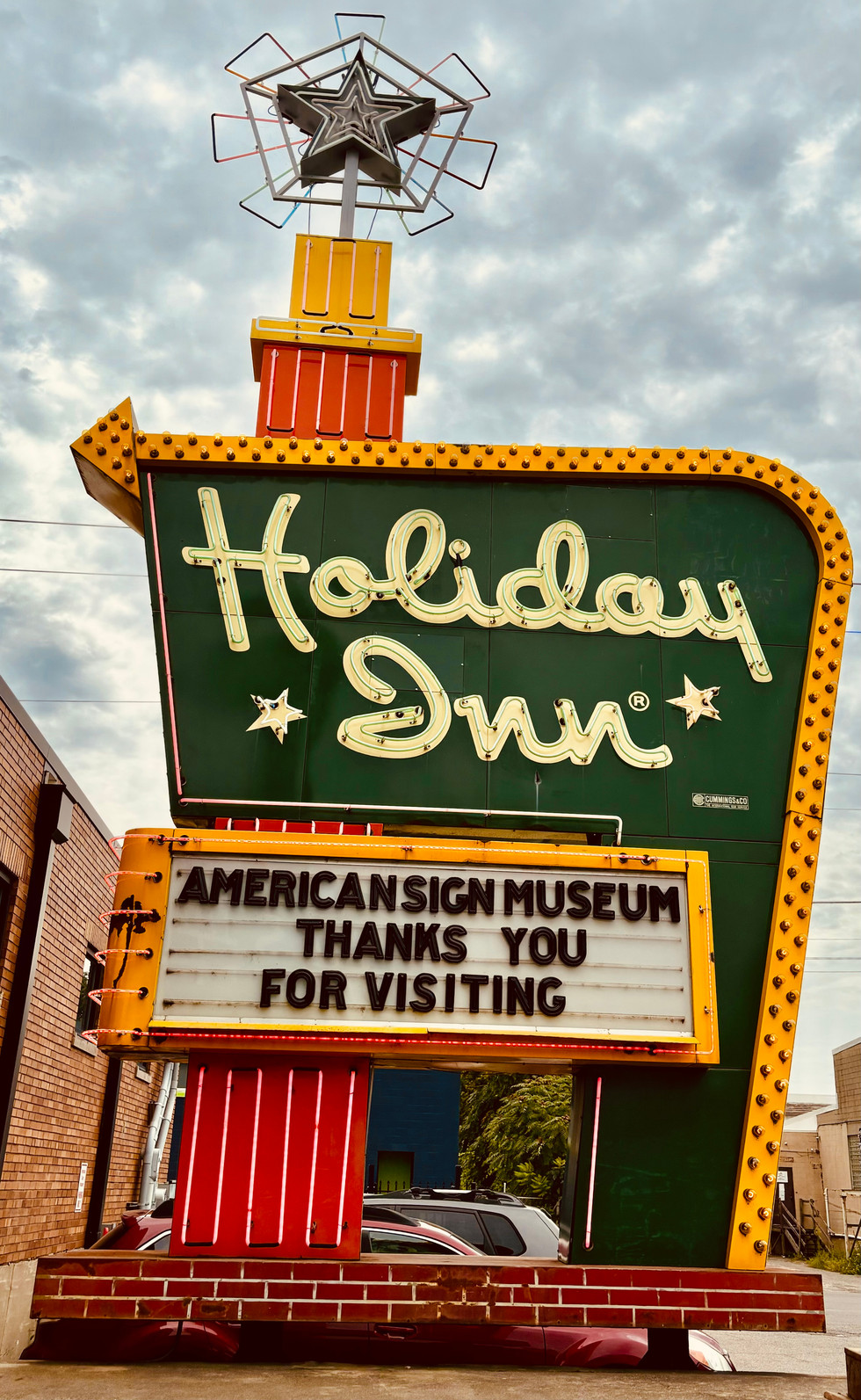Cincinnati Part 3: The American Sign Museum and The Cincinnati Museum Center
- The Anonymous Hungry Hippopotamus
- Sep 30, 2024
- 5 min read
In my first two posts about my visit to Cincinnati, I shared several must-see sites and various must-try foods. If you're looking for other things to do in Cincinnati, Ohio, might I suggest a museum visit? With over 20 museums in the city, there is one that is sure to spark your interest. In my case, there were three. I'll cover the first two museums in this post and save the third for a future post.
American Sign Museum

The first museum on my list was the American Sign Museum, simply because it was so unique. Why visit a museum full of signs? As the museum's website states, signs "reflect the history, technology, commerce, and culture of our communities."
The American Sign Museum is impossible to miss because standing over its entrance is a 20-foot fiberglass genie. The genie was constructed in the 1960s and once welcomed patrons to a carpet cleaning company in Los Angeles, California.
The genie constitutes just one of more than 3,800 signs at the American Sign Museum, the largest public sign museum in the United States. The signs that are displayed cover the span of nearly 100 years.
In addition to the signs, you'll find everything from vintage fuel pumps ...
... to store fronts. That said, the stars of the museum are definitely the signs and the stories they tell.
Howard Johnson Sign
For example, this Howard Johnson sign, created around 1958, was located in Utica, New York and tells the story of the brand's metamorphosis. Today, Howard Johnson is generally associated with lodging, but that wasn't always the case. It originally opened in 1925 as a small pharmacy that sold soda and ice cream. It then blossomed into a restaurant chain.
By the time the above sign was erected in 1958, Howard Johnson was being operated as a motor lodge as well. Nevertheless, the sign still celebrates the brand's history and the 28 flavors of ice cream that the original pharmacy was famous for offering. Simultaneously, the two characters depicted at the top of the sign are inspired by the nursery rhyme, "Simple Simon" and were chosen to promote the family-friendly nature of the hotels and motels that came much later.
Sadly, the last Howard Johnson restaurant closed in 2022 and the lodging component of the brand was acquired by Wyndham Worldwide, making this sign a historical treasure.
As popular as the Howard Johnson sign is, the centerpiece of the museum is this McDonald's sign that was built in 1963 and displayed at a franchise in Huntsville, Alabama.
At that time, the "fast food" designation didn't yet exist.
This sign shows how McDonald's helped to introduce and popularize the fast food classification by identifying the brand as having a "speedy service system." In fact, at the top of the sign is the restaurant's original mascot named "Speedee." That's right, there was a Speedee before there was ever a Ronald McDonald.
The Spinning Globe, a feature at Earl Sheib's automotive collisions and repair shop, has a distinct characteristic that makes it stand out among the rest of the signs at the American Sign Museum. The globe used to be displayed at one of Sheib's flagship stores in Compton, California. While there, it was hit by a bullet.
When the globe arrived at the American Sign Museum, it was restored with a coat of fresh paint and the broken neon tubes were replaced. The museum elected to leave the bullet hole as is however. If you look closely, you can see it.
The museum has another rotating orb referred to as the "Sputnik sign." The sign was envisioned by a businessman in Anaheim, California who wanted to give his shop an interstellar feel during the 1960s when the U.S. was in the space race with Russia. When he couldn't find anybody to build the sign, he decided to build it himself. Pretty impressive.
This Fergi sign is unique because it was multi-purposed. At one time in the 1950s, Fergi was located in front of a car wash and fashioned with flashing white lights to signify a "sparkling clean." The sign was later moved to Terry's Turf Club, a bar in downtown Cincy that was known for being lit in neon.
This sign may not look like much, but it was probably my favorite because it was the only one at the museum that advertised a gas station and ...
... was powered by gas. How appropriate is that? Gas powered lighting was all that was available prior to the late 1890s when electricity was invented. Though this sign is from the 1930s, it continued to use gas to power the internal burners.
In my last post, I promised to circle back to a restaurant called Bob's Big Boy. This was the restaurant's original mascot.
You can tell because the original Bob was red-haired and carried a slingshot in his back pocket.
The modern Big Boy ditched the slingshot, hat and red hair, and went brunette. He also exchanged striped for checkered overalls. He did not give up his signature burger though.
This last sign was made in the 1950s and is positioned at the museum's exit. The Holiday Inn sign was originally located in Las Vegas, Nevada where the flashing, yellow arrow pointed visitors to the hotel's main office.
I highlighted some of the signs that stood out to me during my visit, but there are so many more to see. I would highly recommend a visit to the American Sign Museum if you are in Cincinnati. It is a family friendly excursion that will take some for a sweet trip down memory lane.
Cincinnati Museum Center
The second museum that intrigued me is a one-stop destination where you can visit various museums. Put another way, the Cincinnati Museum Center is a multi-museum complex, inside of which is an Omnimax Theater, a Museum of Natural History and Science, a Children's Museum and the Cincinnati History Museum.
The Museum Center is located inside Union Terminal, a historic passenger railway terminal.
The terminal was constructed in 1933 and is an Art Deco landmark. (For more on Art Deco architecture, see my post on Miami's South Beach neighborhood, where you will find the largest concentration of Art Deco buildings in the United States.)
The entrance to the Cincinnati Museum Center is just behind this beautiful, shell shaped, stepped, cascading fountain.
Just before walking through the main doors, take a moment to gaze upward at the massive, fourteen-foot-wide clock. Not only is it beautiful, it is also weight, as opposed to electricity driven, meaning that the clock is powered by weights on a chain or cable that slowly fall with gravity.
As soon as you enter the Museum Center, you will find yourself in the central rotunda from where you can access the various museums on site. The rotunda is simply grand in size and style. It measures 180 feet wide, with a 106-foot, domed ceiling.
Beneath the dome are shadow mosaic murals created by Winhold Reiss, a New York artist.
The shadows create depth and a three dimensional effect that brings the mosaics to life.
Even if you don't have time or interest in visiting any of the museums, I still suggest visiting the Museum Center. The building itself, which is a National Historic Landmark and a National Civil Engineering Landmark, is more than worth the trip. In addition, from the building's entrance, you get a great view of the Cincinnati skyline.
I visited one more museum while I was in Cincinnati and will share about it in an upcoming post. I also have more restaurants to recommend and bars to suggest for Cincinnati-made beer and spirits. Stay tuned.




































Comments